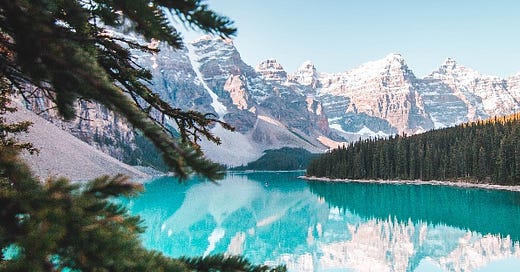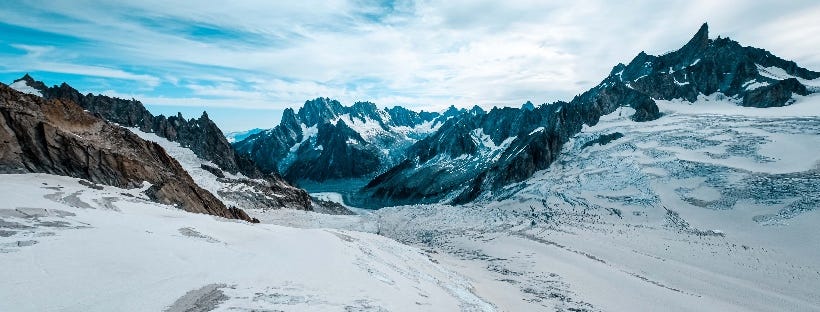The melting of the world's glaciers has nearly doubled in speed over the past 20 years. The scientists who published these findings in nature used high-resolution satellite images to study all glaciers worldwide.
Let's visualize the annual loss of the world's glaciers; the ice sheets of Greenland and Antarctica are not part of this calculation and were not part of the study. Suppose you would build a wall around New York's Central Park with a height of 341 meters (that is higher than the Eiffel Tower and a bit lower than the Empire State Building). Next, you fill this structure with water. And once you have done that, you build another 266 of these odd-sized swimming pools. That is the amount of meltwater from the glaciers that we lose worldwide every single year. And it is an annual volume that is steadily rising.
The glacier melting adds about 21% to the total sea-level rise; some other factors are expanding seawater because of warming and the melting of ice sheets in Antarctica and Greenland. Predicting future sea-level rise is complicated by the unknown factor of how serious the world's leaders will take climate action. More than a meter of sea-level rise by the end of this century is quite well possible. The ice sheets of Greenland, and especially Antarctica, are the ones to worry about most for the long-term effects of sea-level rise.
Himalaya
The glaciers in the rest of the world are essential for the world's ecosystems, their storage capacity, and downstream agriculture because they deliver fresh water in a controlled way. A study in 2019 concluded that a third or more of the Himalayan ice fields would melt this century because of climate change, and it can be significantly more. The melting will have enormous consequences for nearly two billion people who live in the Hindu Kush Himalaya region or live downstream in populous countries like India, Bangladesh, Pakistan, or China.
Rivers like the Ganges and Indus are fed mainly by the runoff from glaciers. Too much melting gives too much water, but devastating water stress in countries like India and Bangladesh is possible in prolonged dry periods in the longer term. Add to the picture increasing demand for water by people, agriculture, mining, and industry. Water scarcity in dry periods risks becoming a source of tensions within communities, countries, or in the case of transboundary waters: between countries.
North America
At least half of the readers of this newsletter live in North America, where the impact of climate change on glaciers is also visible, for instance, in the Rocky Mountains and Alaska.
Glacier National Park could lose all its glaciers completely within decades. In 1910 it was one of the original ten National Parks and had more than 100 glaciers. The last time I visited a couple of years ago, only some 25 were still called glaciers, and all were steadily melting away. I remember reading surprisingly little on the public information displays in the park about climate change, but after some searching, I found one sign that mentioned it.
The internet gave more information, for instance, on the decision that the name of the park will not be changed once the last glacier has disappeared. I'm not sure what to think of that; it feels a bit like calling Mauritius or Reunion 'Dodo Island'. Changing Glacier National Park's name into one that reminds everyone about man-made climate change may fit well with the National Parks' task to educate the public about our responsibility towards nature and the environment.
Apart from the visible reduction of the glaciers, the colors in the lakes are also changing. They change from a brilliant Turquoise blue-green to a more sapphire blue. The fine rock dust in the water reflects the light and creates the turquoise colors that make lakes in Alberta like Moraine Lake and Lake Louise so famous. But now that the glaciers disappear, there will be less rock dust, and the waters will become more transparent.
Today, the Guardian published a set of visualizations revealing how glaciers around the world are shrinking. The newspaper, which is always an excellent source on climate change, based them on a comprehensive inventory of glaciers where scientists worldwide share their data. You can find them here.
Notes:
https://en.wikipedia.org/wiki/Perito_Moreno_Glacier
Photo sources via Pexels, my thanks to the photographers, you can follow them via the links: Errin Casano: Perito Moreno, Argentina. Jaime Reimer: Moraine lake, and Francesco Ungaro: Haute-Savoie, France









Hi Alexander, it's going to be a warm sunny day here. The garden is waiting for me to do my thing . . .
Thank you for writing about one of the planets water reserves held in cold places. I have been to those places, what an experience!
I visited Moraine Lake, a beauty, and the Columbia Ice Fields.
The Columbia Ice Fields is the larges icefield in North America in the Canadian Rockies Mountains. I Walked a ways up the Athabasca Glacier, a finger of the ice fields, until it got to cold. Returned to the lower end and sat down at the foot of the glacier as I watched the meltwater gushing down. The meltwater looks like fat free milk. This glacier retreats at 5 meters(16.4 ft.) per year (current measurements?).
I Walked the terminal moraine at the snout (edge) of the glacier, which is covered with beautiful rocks and wild flowers. Warmed up in the Glacier View Lodge and returned to Lake Louise town. When you drive these local mountain roads you drive on the original glaciers beds, where glaciers back in time carved their way down also . . .
The Incredible Shrinking Glacier - August 10, 2018
https://epod.usra.edu/blog/2018/08/the-incredible-shrinking-glacier.html
Those graphics from the Guardian leave quite an impression. Thank you for sharing that.
I was aware of a few of them in Switzerland - especially the Oberaletsch glacier. We won't be affected be the sea-level rise, but if permafrost is lost, the Alps will crumble. This has already started. I'm not sure about water scarcity in relation to loss of glaciers in Switzerland. Something else to add to my list of things I want to look into. Thank you for this very informative and also quite sobering newsletter.